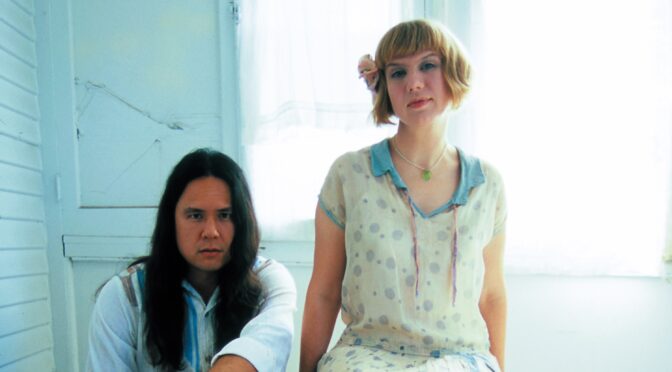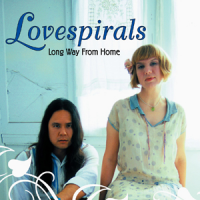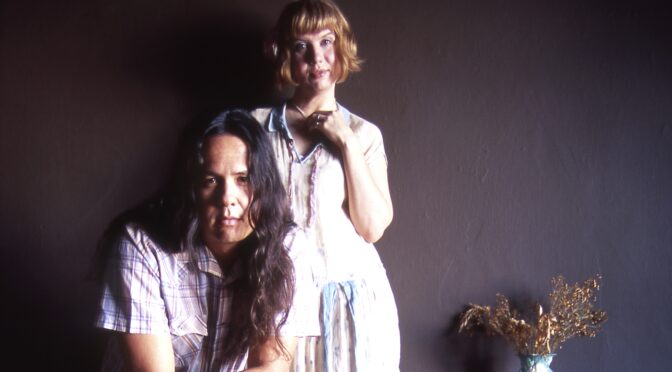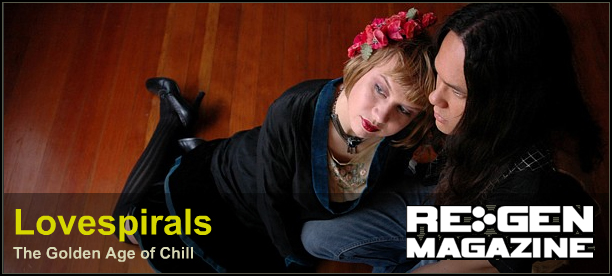 This week’s The Pod 5 show includes Ryan and Anji of Lovespirals as special guests, along with Matthew Ebel and Anji’s fellow ShowGirl, Share Ross, for a discussion of the future of the recording industry. Topics include CDs vs Mp3s, major vs indie labels vs self-released, Radiohead scaring the music industry, and much more fun and madness!
This week’s The Pod 5 show includes Ryan and Anji of Lovespirals as special guests, along with Matthew Ebel and Anji’s fellow ShowGirl, Share Ross, for a discussion of the future of the recording industry. Topics include CDs vs Mp3s, major vs indie labels vs self-released, Radiohead scaring the music industry, and much more fun and madness!
Category Archives: Press
‘Long Way From Home’ Feature Podcast
In this extended podcast episode, Anji and Ryan play each song from their new album Long Way From Home as they discuss how the album was created. In this special behind-the-scenes podcast, the duo talk about the album’s influences, song writing, production secrets, and personal anecdotes. This feature gives you great peek into the album!
- Download the Lovespirals: Long Way From Home Feature promo
- Download the Long Way From Home CD promo
- Buy a jewel case CD or digital download of Lovespirals’ Long Way From Home on Bandcamp
Music Critics Weigh in on Lovespirals' Long Way From Home
Reviews are starting to come in for Lovespirals new album, Long Way From Home, and the critics have been kind.
All Music Guide‘s Ned Raggett writes,
For their third album as Lovespirals, Anji Bee and Ryan Lum again create a lush series of songs that synthesizes disparate influences into a warm, enveloping listen.
Matthew Johnson of Re:Gen Magazine writes,
It’s not an understatement to call Long Way from Home the duo’s most accomplished work up to date; as enjoyable as their previous explorations of laidback electronica and jazz fusion have been, this album captures Lum and Bee’s warm musical chemistry in a way that previous releases only hinted at.
Matt Rowe of MusicTap.net writes,
From the band’s early years as Love Spirals Downwards — with a vocalist all but forgotten for Anji Bee’s lovely, dreamy, and expansive vocal pleasantries — to their current album, Lovespirals have always been a band of change. Their latest, the wonderfully titled Long Way From Home, is one of superior work and can easily rank as the band’s best work in either incarnation.
cadencerevolution.com podcast blogs:
It’s very rare these days to come across an entire CD which you will listen to over and over from beginning to end non-stop, and even rarer to find one which makes you want to grab everyone you know and tell them “you must listen to this.” However such is the case with the third release, Long Way Home, from the California based duo Lovespirals.
Come hear what all the fuss is about at lovespirals.com/longway!
Re:Gen Magazine: Long Way From Home
Matthew Johnson reviews Long Way From Home for Re:Gen Magazine, 11/29/2007
On their third album, Lovespirals shift away from overt electronica in favor of beautiful, understated folk and blues ballads.
If sophomore album Free and Easy saw Lovespirals’ sound at its biggest, Long Way from Home is the duo’s most intimate, forsaking house beats and jazz flourishes for understated slide guitar and acoustic strums. Ryan Lum’s production is more mature than ever before; unless you really listen for it, you won’t be able to tell that he plays and records all the instruments himself – maybe not even then – and the drums sound warm and clear, betraying no hint of sampler or sequencer. Instead, Lum lets his arrangements take center stage, with emotive guitar solos harmonizing with electric organ on the bluesy ballad “Once in a Blue Moon” and relaxed acoustic strums highlighting jazzy piano chords on “Nocturnal Daze.” Anji Bee’s vocals are beautifully languid, the sweetness swathed in melancholy on the plaintive “Caught in the Groove,” adorned by floating background harmonies on “Treading the Water,” and sensual yet dreary on the pair’s stark rendition of classic spiritual “Motherless Child.” Fans of the pair’s more overtly romantic material will appreciate unabashed love song “This Truth,” and there’s even a hint of the ethereal dreaminess of Lum’s previous project, Love Spirals Downwards, on the fuzzy overlapping guitar tones and meandering vocals of “Sundrenched” and “Lazy Love Days.” It’s not an understatement to call Long Way from Home the duo’s most accomplished work up to date; as enjoyable as their previous explorations of laidback electronica and jazz fusion have been, this album captures Lum and Bee’s warm musical chemistry in a way that previous releases only hinted at.
View the original review at Re:Gen Magazine.
Music Tap's Featured Artist, December 2007
Matt Rowe reviews Long Way From Home for Music Tap, 11/28/2007
The evolution of Lovespirals into the band that they are today has been a long road. From the band’s early years as Love Spirals Downwards — with a vocalist all-but-forgotten for Anji Bee’s lovely, dreamy, and expansive vocal pleasantries — to their current album, Lovespirals have always been a band of change. Their latest, the wonderfully titled Long Way From Home, is one of superior work and can easily rank as the band’s best work in either incarnation.
Still a part of the Dream-Pop sound that formed them, the Anji Bee years of Lovespirals have been an essential element for the band. With her ability to wrap around Ryan Lum’s musical explorations, Lovespirals is not afraid of trying on new clothes, framing them in gorgeous soft tones of various flavours. The album begins with a “career-best” blues song that accentuates the album’s direction. “Caught in the Groove” is a beautifully produced, dream-blues (if I may coin the phrase) song. Using a song as a metaphor for the deterioration of a relationship, this captivating tune is made all the more extraordinary by Lum’s blues guitar.
That same bluesy guitar shows up in “Once in a Blue Moon, and “Nocturnal Daze.” Ryan Lum’s guitar leads have a distinct ’70s feel throughout the album. Some songs recall the past musical history of the band. “Sundrenched” lends itself to the stream of that past. The album closes with the excellent musically and lyrically sex-soaked “Lazy Love Days.”
The needle may be “caught in the groove” but, for me, that’s a good thing where this album is concerned.
View the original post at MusicTap.net
Re:Gen Magazine: The Golden Age of Chill
The Golden Age of Chill by Re:Gen Magazine Assistant Editor, Matthew Johson:
For a band so enmeshed in ’70s-era recording aesthetics, Lovespirals’ Anji Bee and Ryan Lum are undeniably on the cutting edge of modern technology. Early adopters of podcasting technology, the pair are aligned with Adam Curry’s PodShow network as well as the nascent podsafe movement. They also recently made their virtual reality debut with a live show in the Second Life online community, and are eager about the Internet’s role in the music industry’s uncertain new era.
Get them talking about the music itself, though, and it’s all about the warm sounds of ’70s records. Bee and Lum’s newest release, Long Way from Home, largely abandons the house and downtempo electronic currents of previous releases Windblown Kiss and Free and Easy not to mention the ambient drum ‘n’ bass predilections Lum explored with his previous project, top-selling Projekt act Love Spirals Downwards in favor of a more acoustic approach. If the technology is less overt, however, it’s no less an integral part of Lovespirals’ music. As Lum and Bee explain to ReGen, it takes a lot of technique to produce an album on ProTools that sounds like it was recorded in the days of Miles Davis and John Coltrane. Lum also tells us about revisiting his early work by remastering new editions of Love Spirals Downwards’ first two albums, Idylls and Ardor, and Bee talks about keeping things real in the age of Auto-Tune.
Let’s start by talking about your new album, Long Way from Home. The electronic elements are a lot more understated than on Free and Easy. Was there a conscious decision to step away from electronica to focus on more traditional instruments?
Lum: Big time! There’s really no electronics, unless you count the Rhodes piano. I think three or four songs have Rhodes, some a lot of Rhodes, some just a little bit. I don’t know if that makes it electronica. I just see it as a popular ’70s instrument that got re-popularized.
Bee: Bands like Zero 7 and Air have really re-popularized Rhodes, so it’s easy to think of Rhodes as being an electronica thing. I’m happy to let it slide; if we’re considered ‘downtempo’ because of the Rhodes, that’s fine. We did basically record the same way as Free and Easy; we used ProTools, and the drums are not real drums.
Lum: It may not sound like it, but I’m using all the production techniques I’ve learned over the years, making Free and Easy, or before that making drum ‘n’ bass or house or whatever. We’re using the same techniques, but we’re trying to make more acoustic records with the same gear.
Bee: It’s like we’re disguising the techniques.
Lum: You can make a drum machine sound all electronic, but we’re trying to make it sound as human as possible. In fact, I’m hoping you can’t even tell it’s not a real guy playing a real drum.
Anji Bee of Lovespirals interviewed on Bite Size Bonus podcast
 Lovespirals vocalist/lyricist, Anji Bee, was interviewed by GD about the band’s new album, performing in Second Life, and more on Bite Size Episode #509. To hear this podcast, you must sign up for a free subscription to the BsB Members Only Podcast. BTW, GD holds the honor of being the UK’s first podcaster, and he has long been a supporter of Lovespirals podsafe music.
Lovespirals vocalist/lyricist, Anji Bee, was interviewed by GD about the band’s new album, performing in Second Life, and more on Bite Size Episode #509. To hear this podcast, you must sign up for a free subscription to the BsB Members Only Podcast. BTW, GD holds the honor of being the UK’s first podcaster, and he has long been a supporter of Lovespirals podsafe music.
All Music Guide reviews Long Way From Home
Ned Raggett reviews Long Way From Home for the All Music Guide
For their third album as Lovespirals, Anji Bee and Ryan Lum again create a lush series of songs that synthesizes disparate influences into a warm, enveloping listen. For all that the duo’s roots have been seen as being goth, their previous albums touched on a variety of approaches with aplomb, and at this point it’s just as accurate — and ultimately limiting — to say that Long Way From Home is blues, or country, or rock and roll. It’s a blend that has a low-key presentation, an easygoing pace, and an ear for all kinds of unexpected details that change the feeling of a song in an instant without disrupting it. The traditional standard “Motherless Child,” where the album title comes from, shows this clearly, where the harrowing lament of the lyric becomes a cool flow, Bee’s vocals paying homage to famous interpreters of the song like Sarah Vaughan and Billie Holliday without trying to actually replicate them. Meantime, a song like “Caught in the Groove” has a gentle, echoed percussion flow that sounds like late eighties Cocteau Twins, twangy guitars and piano that suggests majestic early seventies country, and Bee’s coolly sweet vocals calling to mind crooners from an even earlier time. This resplendent variety, which defines the sound of much of the album, helps the band further cement its own protean sound, increasingly recognizable on its own merits rather than just being the sum of its many parts. Some individual moments feel very thrilling — the wheezing guitar/harmonica background to “Treading the Water,” the sudden low-key funk on “Lovelight” — without overwhelming the overall flow, a fine balancing act.
View the original post on the All Music Guide
Shameless Plugcast Features Lovespirals
 [audio:http://media.podshow.com/media/4489/episodes/86572/shamelessplugcast-86572-11-08-2007_pshow_202369.mp3]
[audio:http://media.podshow.com/media/4489/episodes/86572/shamelessplugcast-86572-11-08-2007_pshow_202369.mp3]
Download Lovespirals’ Shameless Plugcast MP3
Zack Daggy interviews Ryan Lum and Anji Bee of Lovespirals about their band history, musical process, brand new album, Long Way From Home, and more in a Shameless Plugcast feature. Included in the show are two podsafe Lovespirals songs. Zack’s also running an autographed CD contest – see shamelessplugcast.com for details!
Cadence Revolution reviews Long Way From Home
Cadence Revolution reviews Long Way From Home, 10/27/2007
It’s very rare these days to come across an entire CD which you will listen to over and over from beginning to the end non-stop, and even rarer to find one which makes you want to grab everyone you know and tell them “you must listen to this.”
However such is the case with the third release, Long Way Home, from the California-based duo Lovespirals, consisting of Anji Bee on vocals and Ryan Lum on instruments.
Fusing sounds from jazz, chill, folk, Americana and even a touch of country, this latest release will grab you and wrap you in an aural blanket of warm with a soothing hand on the brow that shows off why the indie music scene is our salvation from the commercial corporate music machine, and Lovespirals is one of it’s shinning stars.
From the opening jazzy/country sound of the aptly named “Caught In The Groove”, to the groovy feel of “This Truth”, to the lazy summer afternoon feeling of “Sundrenched” this CD is a wonderful blend of vocals and music coming together in an intertwining dance of harmony deftly expressing emotions in both delivery and composition.
Perhaps the one track that shows off their ability to combine emotion with production is the track “Motherless Child”, which had been released as a remix by MoShang on his Asian Variations CD earlier this year. On the Long Way Home version, Lovespirals have gone with a less-is-more approach and stripped the song down to the barest and starkest in this presentation.
Anji’s emotion-filled delivery holds nothing back in delivering the full emotion of grief and loss. While Ryan’s haunting and simple layered guitar work echoes her delivery, but neither overpowers the other, and the two come together to powerfully capture the feeling of being alone and isolated.
Throughout Long Way Home, the duo convey a wide range of feelings and emotions as words and music come together or swirl around and through each other in a mesmerizing dance of audio.
Lovespirals have found the perfect balance, resulting in a release that never falters from one track to the next that is rare these days, and is the perfect aural vacation everyone should take at least once a day.
View the original post at Cadence Revolution
Lovespirals Feature on PodShow Radio
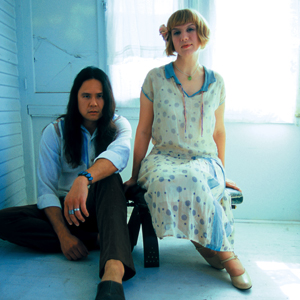 Lovespirals are the featured artist on this week’s PodShow Radio. Host, Brent Bradley, presents 43 minutes of podsafe Lovespirals tunes selected from all 3 albums, including their brand new single, “This Truth,” from Long Way From Home. The band also give a little background on why and how they recorded a cover of “Motherless Child.” It’s a very smooth production you won’t want to miss!
Lovespirals are the featured artist on this week’s PodShow Radio. Host, Brent Bradley, presents 43 minutes of podsafe Lovespirals tunes selected from all 3 albums, including their brand new single, “This Truth,” from Long Way From Home. The band also give a little background on why and how they recorded a cover of “Motherless Child.” It’s a very smooth production you won’t want to miss!
[audio:http://m.podshow.com/media/174/episodes/81799/podshowradio-81799-10-03-2007.mp3]
Anji Interviewed on Shameless Plugcast #2
[audio:http://media.podshow.com/media/4489/episodes/61521/shamelessplugcast-61521-05-17-2007_pshow_70363.mp3]
Anji is the special guest on today’s Shameless Plugcast, being interviewed by show host, Zack Daggy, about Lovespirals, vocal influences, podcasting, vidcasting, radio DJing, The Chillcast, Unwind, Lovely Ladies et al, plus a listener question from Ed Ovett, of Ed’s Mixed Bag Podcast.

